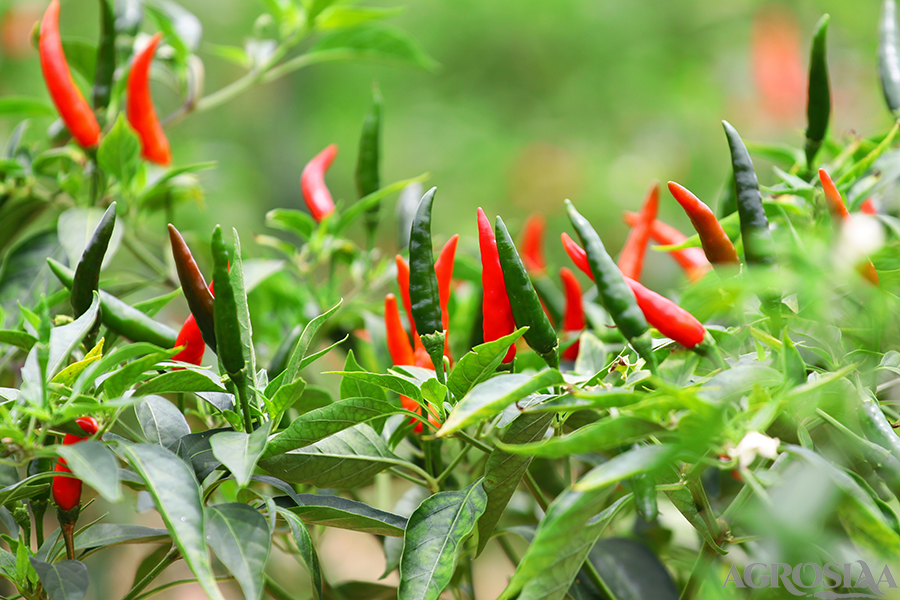Mirchi
Solanaceae
Capsicum annum
Improved varieties
Agnirekha, Phule Jyoti, Phule Sai, |Andhra Jyoti or G-5, Bhagya laxmi, Sindhuri , Prakash, Hissar sakthi, NP 46 A, Arka lohit, Musalwadi selection, Phule Mukta, Phule suryamukhi, Sankeshwari
Hybrids - Pusa jwala, pusa sadabahar, Punjab lal, kiran
Chilli is kharif season crop
Chilli is grown in both tropical and subtropical areas. For vegetative growth it requires warm humid climate. For fruit maturity it requires warm dry weather. It requires annual rainfall of about 800-1200 mm. Heavy rainfall leads to poor fruitset and high humidity leads to fruit rot. In winter temperature should not beless than 20-25 0 c because low temperature affects fruit and flower setting.
chilli can be grown on a wide variety of soils provided. They are well drained well aerated and rich in organic manure . In ill drained soils plants shed their leaves and turn sick. Cannot tolerate water logging conditions. Sandy loam soil with adequate irrigation and manuring can support better crop of chilli. Black soils also preferable to grow chillies as rainfed crop. Acidic and alkaline soils are not suitable chilli can be grown in saline soils. Ideal pH is 6-7.
Nursery planting- Nursery bed should be prepared to a size of 6 meter length 1
meter width and 15 cm raised. Raised beds are preferred than flat beds because on
flat beds root development is poor and incidence of damping off is more well
decomposed FYM @ 20-25 kg per bed is mixed thoroughly in seed bed in one
month advance. 30-40 gm dithane M-45 or 15 gm Phorate mixed in soil. Seeds
are treated with fungicides like Capton 2-3 gm per litre to prevent seed borne
diseases. Seeds are sown preferably 5 cm lines. Paddy straw used for mulching.
Mulching is removed as soon as seeds start germination.
Transplanting- seedlings ready for transplanting 35 to 45 days. Seedlings are
transplanted singly different spacing. For heighted varieties 75 x 60, 60 x 60 , for
short varieties 60 x 45 .
seeds are treated with 2-3 gm Thiram / kg. Seedlings are deeped 15 minutes in 10 gm Profenophos + 25 gm Dithane M-45 + 30 gm Sulphur in 10 lit water
-
Transplanting, seedlings are sown on ridges and furrows.
Chilli seeds are sown in nursery beds during May- July. In south states where rainfed cultivation is chillies can be in May- June and Septemebr to October.
Long and spreading varieties –
Distance between rows 75 cm
Distance between plants 60 cm
Short varieties
Distance between rows 65 cm
Distance between plants 60 cm
-
For improved varieties 1.0 to 1.25 kg/ha
For hybrid 400-500 gm seed is required /ha.
Hand weeding and hoeing is done when ever necessary. At the time of flowering stage earthing up is necessary to avoid lodging.
Before transplanting apply 20-25 tones FYM /ha in soil. For chilli 100 kg N : 50 kg P2O5 : 50 kg K2O. At the time of transplanting ½ Nitrogen full dose of P and K and remaing nitrogen dose 4-6 weeks after transplkanting means flowering and fruiting stage. Give irrigation after fertilization.
First irrigation is given just after transplanting for better establishment in the soil. Second irrigation is given 10 days after transplanting . Afterwards irrigation is given as per the requirement. Generally 8-9 irrigations have given depending on rainfall, soil type , humidity and temperature. Method of irrigation adopted is ridges and furrows.
Weeding is done whenever necessary. Herbicides like Alachlor 2.5 kg per ha can be used on chillies.
On chilli fruit rot, wilting of branches, and leaf curl. For fruit rot and wilting of branches destroyes infected branches. Spraying of dithane-M- 45 or Blitox 25 to 30 gm in 10 liter water at the interval of 15 days. 3 to 4 spraying ar necessary. For Downey mildew suphur EC 30 gm or Bavisting 10 gm or Karothene 10 ml in 10 lit water 2-3 spraying at the 15 days interval. Leaf curl 25 days after transplanting Dithane M-45 (25 gm) in 10 liter water + 30 gm Sulphur + 10 ml Profenophos 15 days interval 4-5 spraying.
Flower flies , spider, fruit eating catterpiller for control of this insects seeds are treated with Carbosulphan 30 gm + Trichoderma 5 gm/kg. At the time of transplanting seedlings are treated with Emidachloprid 10 ml or Carbosulphan 30 ml _ Trichoderma 50 gm in 10 liter water. After transplanting apply 10-15 day Nimboli cake 400-500 kg/ha.
-
1) Flowering begins 40-60 days after transplanting depending upon variety, climate , nutritional.
2) Status of plant fruits starts ripening about 3 months after transplanting and picking may go on for 2-3 months.
Grading and cleaning and dry in yard for 3-4 days and then stored in gunny bags.
Commercial chilli variety yield 10-15 qtls/ha
Irrigated = 15-20 qtls /ha
Green chilli= 100 to 150 qtls /ha
Dry chilli= 20-25 qtls /ha
Green chillies can be stored for about 40 days at 0 0 c.
Dried chillies can be kept for a month in dry places well proteced from insect pests.
Stored in gunny bags , polythene bags, net bags.
Vegetable purpose, pickles, spices , beer industry beverages.
1) Green chillies are rich in proteins 2.9 gm per 100 gm, Ca, Mg, P, K, Cu and S.
Vitamins like Thiamine, Riboflavine and Vitamin C.
2) Chillies are the major ingredients in curry powder.
3) Chilli pulp is pickled in strong vinegar or brine.
4) Extract of chillies are used in the production of Ginger beer and other beverages.
5) Green chillies are rich in Rutin which is pharmaceutical use.
6) Pungency of chillies is due to capsaicin pigment in chillies is due to capsanthin
also contains many other oleoresins.
Grading , Cleaning and packed in gunny bags , Spices, Pickle Industry
Peru, South America, India Andhra Pradesh, Guntur, Hissar, Maharashtra
-
-
-










